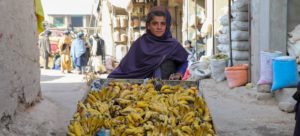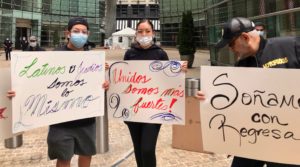For a few months in the fall of 2021, reports of going untested violence, abuse and neglect prison on New York City’s Rikers Island made headlines across the national news before returning to the revolutionary cruelty that constitutes American life. Here special insurance about the atrocities behind bars that sparked global condemnation. But in a brief stint at the forefront of political discussion and the mass media, this media “event” failed to explain the most disturbing reality at play: Rikers are everywhere. place.
Last week, while acknowledging that “people are dying” from being left in prison, however, a federal judge granted New York City Mayor Eric Adams has more time to avoid Riker being brought in federal admission—A threatening slap on the wrist for the city’s constant death refuse respect the constitutional rights of the people it nests in. As Rikers continues to come under scrutiny, both the national media and the federal government ignore that the conditions noted at Rikers are closer to the norm than the exception in U.S. healthcare facilities. Ky.
Abnormal conditions at the Harris County Jail in Houston, for example, drove even more deaths last year than at Rikers, and parallel protracted crises continue across the country. In the deadliest two years so far in their history, a large percentage Prisons and Prisons of the United States have proven themselves incapable of carrying out their legal obligations to ensure safe conditions for the people they keep within their walls. Even before the pandemic, all 50 states reported an inability to hire staff at the appropriate levels for basic safety. This has significantly worse are from.
Prison and prison administrators have responded by dramatically increasing their reliance on solitary confinement as a supposed “protective” measure, with the submission of 80,000 people in solitary confinement on an average day in “normal time” about 300,000 won held under such conditions during the pandemic. When implemented for more than 15 days, it has long been accepted as standard operating procedures At US facilities, solitude is defined by the UN as torture and gross violations of human rights. Abusive conditions like these, along with bad conditions (and illegal) health care shortages in prisons and prisons, have led to significant increase in suicides, homicides, overlooked medical emergencies, general neglect of health care, and COVID-19 outbreak among detainees. And, in the context of absent data and audit system along with incentives cover abuse inside prisons and prisons, however bad things can appear on paper, they are certainly much worse in reality.
In response, many officials did what New York City is propose for Rikers: shutting down the worst performing facilities while simply redistributing those they hold. For example, at least 12 states have closed prisons in the past year related to shortage of personnel and systematic abuse reporting, violenceand general disorder. While this looks like a win for the prison reform movement, these states all refuse to combine the closures with a substantial reduction in incarceration. Without both releasing detainees — starting with hundreds of thousands of people continuing to be detained, data displaydoesn’t stop the violence and instead actually lead to an increase in crime—And deal with the criminalization of poverty, officials Simply reposition and focus chronic overload.
As partial reform decouple from a pragmatic vision and plan for more transformative change than aggravate and prolong Health and safety conditions cannot be guaranteed in prisons and prisons. Bringing in facilities like Rikers federal admission—That is, under the control of the federal government, not the state or the city — without addressing the root causes is likely to do so. While this would allow federal entities to circumvent existing laws, local politiciansand correctional officer’s union contract is preventing prisons from meeting its constitutional obligations, it will once again ignore the fact that US prisons are harmful by design, not aberration.
As legal scholar and criminologist Mark Findlay Written four decades ago when mass incarceration was still in its infancy, “As long as prison reformers try to work within the existing re-education system to rehabilitate it, re-education is doomed to renovators are certainly conditioned to accept the maintenance of the basic rehab structure in exchange for minor corrections”.
What reformism overlooks is that it is the internal conditions of incarceration that are harmful to the health and safety of detainees, Staffand great public. For example, consider that even before COVID-19 increased the harm caused by incarceration, one study estimated that a person incarcerated would lose two years of future life for every year locked up; another study roughly calculates five years of life lost alone age 40. And these life-shortening consequences of incarceration also affect family members, communityand finally, the whole country. When one in three black people in the United States are incarcerated for their entire lives, and men of all backgrounds face an 11% chance of lifetime incarceration, the sheer magnitude of harm posed by the U.S. sanctions system. unintelligible.
The COVID-19 pandemic, by turning the age-old violence of incarceration into an epidemic for all of us, has made a long-repressed reality all the more relieved. Conditions inside prisons, prisons, and criminalized neighborhoods are inseparable from the health of wider communities. Thus, legislators’ ostensibly attempts to build public safety through short-sighted systems of segregation like incarceration will make the boomerang return as multiply harm for everyone.
During the COVID-19 pandemic, prisons and prisons have acted as anti-epidemic engines core and spread disease in surrounding communities. My own researchPoint out, for example, that the spread of the prison-related coronavirus has resulted in millions of COVID-19 cases and tens of thousands of deaths. Here epidemiological dynamics dates back to long before COVID-19 and if we don’t make major changes, it will continue long after the current pandemic has passed.
The truth is that the system of policing and detention has been at the heart of America’s “public safety” policy for the past half century, in fact, basically incompatible with shared safety. This cannot be fixed through superficial administrative reorganization, such as recruitment private contractor as short-term guardians, bringing National Guarduse Funding of the CARES . Act build more prisons and jails, increase police funding, put abuse facilities under federal control, or closing the worst prison or jail only to transfer detainees from one harmful setting to another.
In defense of his prison reform proposal and in an effort to maintain control of the city over Rikers, Mayor Adams’ Department of Corrections commissioner, Louis Molina, claim that “change must come from within” and not through outside interventions. In contrast, abolitionist justices like Angela Davis, Ruthie Wilson Gilmore and Mariame Kaba insist that systems built on racist, violent grounds cannot provide precise solutions. As they have pointed out, to suggest that we must place our trust in the US carceral system for self-correction, at best, reflects a profound naivete and historical ignorance. At its more realistic worst, it reflects a callous strategy used by those in power to keep their positions at the expense of people.
Getting out of our nation’s cannibal nightmare will require forcing large-scale implementation for system administrators who don’t want to, like Commissioner Molina and Mayor Adams and their counterparts. nationwide. As confirmed in the consensus expert recommendations for reduction due to both National Academy and American Public Health Associationthis means investing in the release and reentry into the society of about 1 million won people have confinement is taking place does not serve a legitimate public interest. It also means investing in police-free, housing-, and police-free public safety systems –– like a country corps of public health workers––To stop counterproductive capture cycle. Yet despite ample scientific evidence of the rational necessity of such action, politicians fearful of appearing “soft on crime” have refused to take responsibility for implementing change.
In the rare cases where physical abuse has garnered significant media attention, policymakers — both Republican Party member and Democratic Party member—Along with judges, prosecutors and prison officials often react by expressing shock, as if they had never heard of the barbaric reality of these systems. Next, these officials released empty call Because incremental reform until the problem faded again from public view.
Similarly, during the ongoing emergency inside prisons and prisons, federal and local officials repeatedly complained about their alleged impotence while refusing to use quantity reduction tool at their disposal. President Biden has failed to show leadership; instead, he is repeat What has brought us to this point? And Congress did not do better, refusing to enact real public safety policies, such as those outlined below. BREATHE Act framework that reallocates funding from failed prison and policy models and redirects it to supportive social services much more efficient prevent violence. When significant parts of the rule change such patterns — such as The People’s Response Act and The Counseling Act Doesn’t Criminalize in Schools—Introduced, they were largely ignored. Meanwhile, as mass shootings decimate more families and communities with each passing week, preventable deaths continue unfazed by police or prison ghosts.
It’s been a long time since we’ve faced the irrationality of spending $280 billion taxpayer dollars for annual control and punishment and other amounts 768 billion dollars for militaristic illusions of “national security” while hundreds of thousands of Americans are killed each year due to severely inadequate health, labor, and welfare systems. The reality is it won’t be safe in the US until we get rid of our irresistible carceral system and build in its place. public infrastructure need to reverse a half-century of persistent investment in cruelty rather than care.
Other must-read stories from TIME




